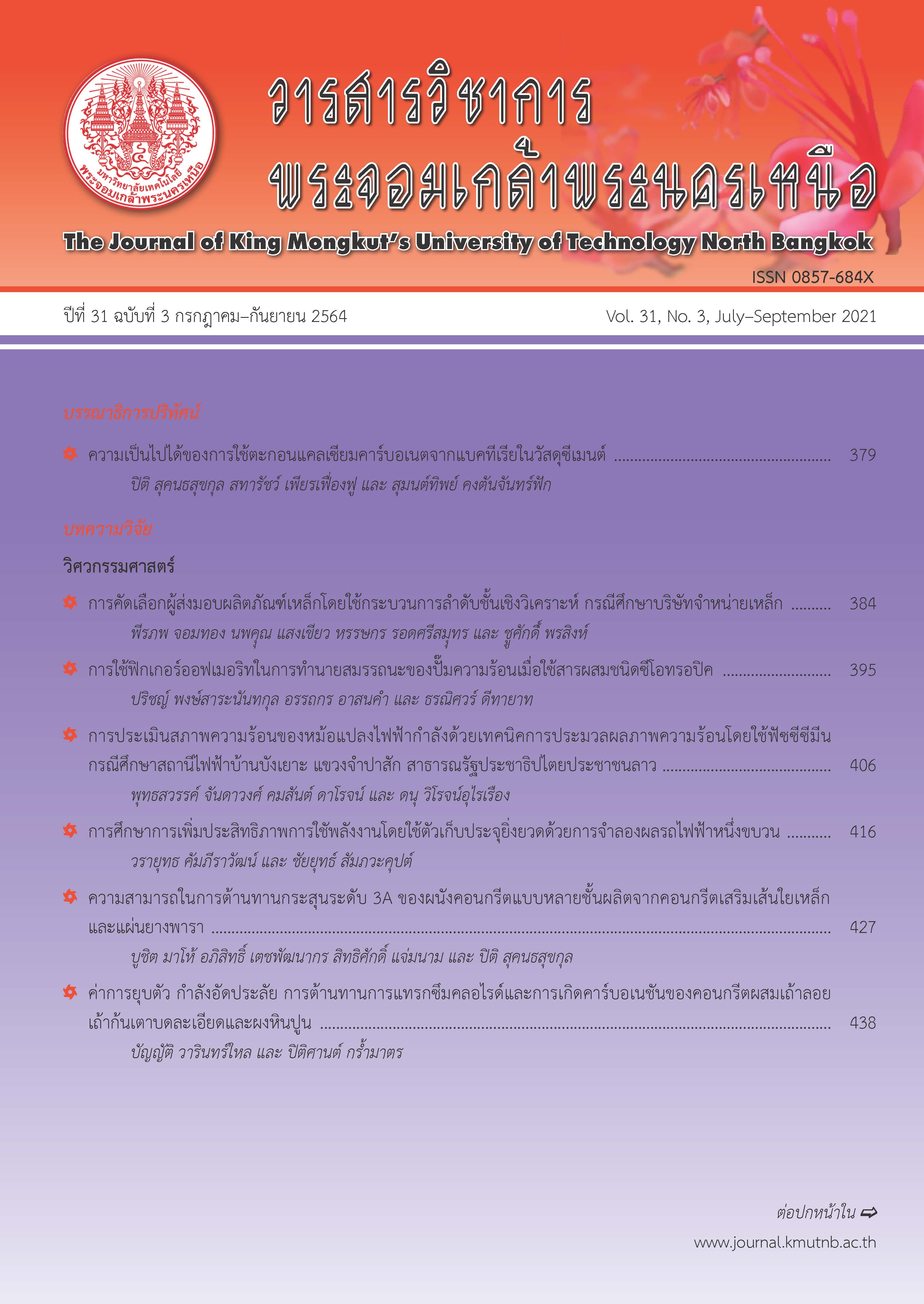การออกแบบชุดทดลองอย่างง่ายสำหรับวัดการดูดกลืนแสงในการสอนเคมี: การหาปริมาณน้ำตาลในเครื่องดื่ม
Main Article Content
บทคัดย่อ
ตัวต่อเลโก้ซึ่งเป็นหนึ่งในของเล่นยอดนิยมสำหรับหลายคนในทุกช่วงวัยได้ถูกนำมาใช้เป็นวัสดุหลักในการสร้างชุดทดลองวัดการดูดกลืนแสงของสาร โดยมีแนวคิดในการออกแบบคือ ทำจากวัสดุที่หาได้ง่าย ลดความซับซ้อนของส่วนประกอบภายในลงเพื่อให้ง่ายต่อการทำความเข้าใจในหลักการของการดูดกลืนแสง ผู้เรียนสามารถประกอบด้วยตนเองได้ ชุดทดลองสามารถใช้เป็นนวัตกรรมสื่อการสอนในการจัดการเรียนการสอนที่ส่งเสริมให้ผู้เรียนได้เรียนรู้ผ่านการลงมือทำภายใต้สถานการณ์จริงในหัวข้อวิธีทางสเปกโทรสโกปี กฎของเบียร์-แลมเบิร์ต เป็นต้น ชุดทดลองที่พัฒนาขึ้นถูกนำมาทดสอบประสิทธิภาพการทำงานโดยใช้วัดค่าการดูดกลืนแสงเพื่อวิเคราะห์หาความเข้มข้นของสารละลาย 3 ชนิดซึ่งเตรียมขึ้นมาในห้องปฏิบัติการ จากนั้นถูกนำไปใช้ในบริบทจริงโดยใช้วิเคราะห์หาปริมาณน้ำตาลในเครื่องดื่มที่ขายตามท้องตลาด 3 ยี่ห้อ ผลการทดสอบพบว่า ปริมาณน้ำตาลในเครื่องดื่มทั้ง 3 ยี่ห้อที่วิเคราะห์ด้วยชุดทดลองให้ค่าที่ใกล้เคียงกับที่ปรากฏข้างขวดโดยมีความคลาดเคลื่อนสัมพัทธ์อยู่ในช่วง ?5% และมีค่าส่วนเบี่ยงเบนมาตรฐานสัมพัทธ์น้อยกว่า 5% ซึ่งแสดงถึงความถูกต้องและความแม่นยำในการวัดของชุดทดลองที่ทำงานอย่างมีประสิทธิภาพ
Article Details
บทความที่ลงตีพิมพ์เป็นข้อคิดเห็นของผู้เขียนเท่านั้น
ผู้เขียนจะต้องเป็นผู้รับผิดชอบต่อผลทางกฎหมายใดๆ ที่อาจเกิดขึ้นจากบทความนั้น
เอกสารอ้างอิง
[2] S. Pradub, T. Teptit, and V. Vailikhit, “Smart phone photometry for undergraduate chemistry courses,” Journal of Education Naresuan University, vol. 20, no. 2, pp. 233–240, 2018.
[3] Z. Liu, Y. Zhang, S. Xu, H. Zhang, Y. Tan, C. Ma, R. Song, L. Jiang, and C. Yi, “A 3D printed smartphone optosensing platform for point-of-need food safety inspection,” Analytica Chimica Acta, vol. 966, pp. 81–89, 2017.
[4] J. Asheim, E. V. Kvittingen, L. Kvittingen, and R. Verley, “A simple, small-scale lego colorimeter with a light-emitting diode (led) used as detector,” Journal of Chemical Education, vol. 91, no. 7, pp. 1037–1039, 2014.
[5] P. Hu, Y. Chen, and S. Sonkusale, “Low cost spectrometer accessory for cell phone based optical sensor,” in 2015 IEEE Virtual Conference on Applications of Commercial Sensors (VCACS), Raleigh., NC, 2015, pp. 1–5.
[6] S. J. Tavener and J. E. Thomas-Oates, “Build your own spectrophotometer,” Education in Chemistry, vol. 44, pp. 151–154, 2007.
[7] D. R. Albert, M. A. Todt, and H. F. Davis, “A low-cost quantitative absorption spectrophotometer,” Journal of Chemical Education, vol.89, no.11, pp.1432–1435, 2012.
[8] R. McClain, “Construction of a photometer as an instructional tool for electronics and instrumentation,” Journal of Chemical Education, vol. 91, no. 5, pp. 747–750, 2014.
[9] J. R. Vanderveen, B. Martin, and K. J. Ooms, “Developing tools for undergraduate spectroscopy: An inexpensive visible light spectrometer,” Journal of Chemical Education, vol. 90, no. 7, pp. 894–899, 2013.
[10] S. Tuntirojanawong. (2017, May). A direction of educational management in the 21st century. Veridian E-Journal. [Online] (in Thai). 10(2), pp. 2843–2854. Available: https://he02.tcithaijo.org/index.php/Veridian-E-Journal/article/view/109763/86192
[11] N. Tungkananuruk and K. Tungkananuruk, Analytical spectroscopy. Bangkok: Kasetsart University Press, 2004 (in Thai).
[12] D. F. da Silva and D. Acosta-Avalos, “Light dependent resistance as a sensor in spectroscopy setups using pulsed 21st century light and compared with electret microphones,” Sensors (Basel), vol. 6, no. 5, pp. 514–525, 2006.
[13] P. Supawan, Regression Analysis. Bangkok: Phranakhon Rajabhat University Press, 2013 (in Thai).
[14] PerkinElmer. (2017, May). Application note: determination of sugar as glucose in a soft drink using the LAMBDA PDA UV/Vis spectrophotometer. PerkinElmer, Inc., USA. [Online]. Available: https://www.perkinelmer.com/lab-solutions/resources/docs/APP-Determination-of-Sugar-as-Glucose-in-Soft-Drink-using-LAMBDA-465-012356A_01.pdf
[15] M.-C. Wu, M.-P. Lin, S.-W. Chen, P.-H. Lee, J.-H. Li, and W. Su, “Surface-enhanced Raman scattering substrate based on a Ag coated monolayer array of SiO2 spheres for organic dye detection,” RSC Advances, vol. 4, no. 20, pp.10043–10050, 2014.
[16] K. Knagge and D. Raftery, “Construction and evaluation of a LEGO spectrophotometer for student use,” The Chemical Educator, vol. 7, pp. 371–375, 2002.
[17] P. Palachai and S. Muncharoen, “A simple experiment to evaluate the equilibrium constant of bromothymol blue using smart phone for high school students,” SWU Science Journal, vol.22, no. 2, pp.1–14, 2017 (in Thai).
[18] L. Kaijanen, M. Paakkunainen, S. Pietarinen, E. Jernström, and S. Reinikainen, “Ultraviolet detection of monosaccharides: Multiple wavelength strategy to evaluate results after capillary zone electrophoretic separation,” International Journal of Electrochemical Science, vol. 10, no. 4, pp. 2950–2961, 2015.
[19] G. L. Miller, “Use of dinitrosalicylic acid reagent for determination of reducing sugar,” Analytical Chemistry, vol. 31, no. 3, pp. 426–428, 1959.
[20] K. Miloski, K. Wallace, A. Fenger, E. Schneider, and K. Bendinskas, “Comparison of biochemical and chemical digestion and detection methods for carbohydrates,” American Journal of Undergraduate Research, vol. 7, no. 2, pp. 7–18, 2008.
[21] N. Moonrungsee, C. Prachain, C. Bumrungkij, N. Peamaroon, and J. Jakmunee, “A simple device with a smartphone camera for determination of salicylic acid in foods, drugs and cosmetics,” Journal of King Mongkut's Institute of Technology North Bangkok, vol. 28, No. 3, pp. 639–648, 2018 (in Thai).

